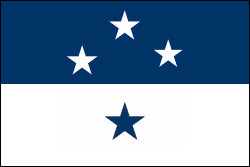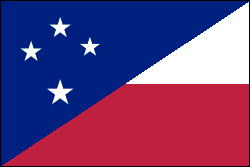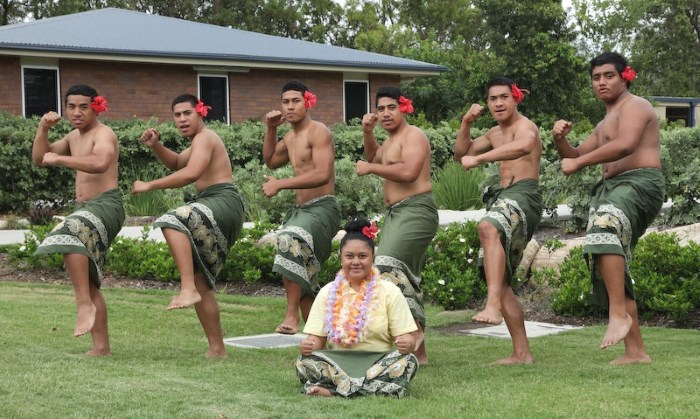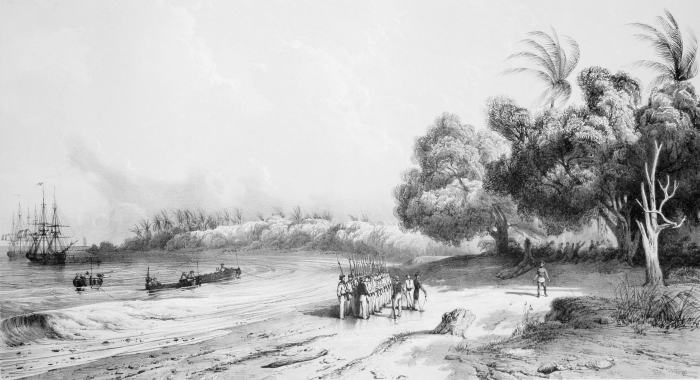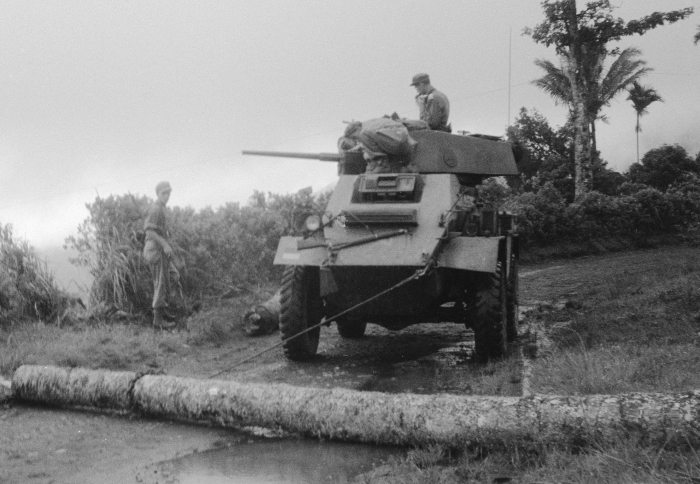  Frilandic TagaloaFrilandic Tagaloa (Frilandisk-Dagalau) is an overseas territory of the kingdom of Friland, situated in the southwest Pacific. 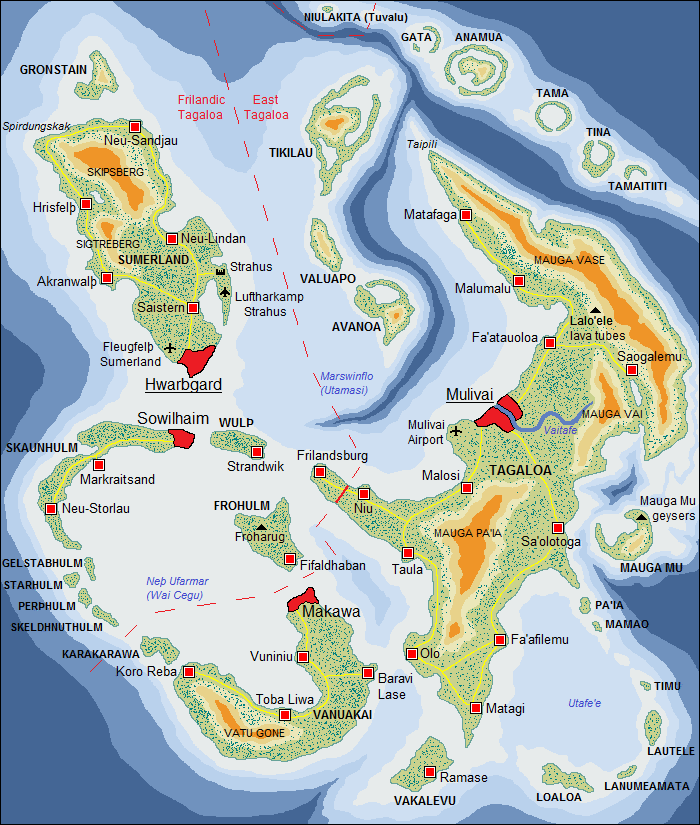 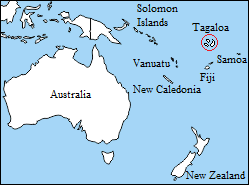 General information
General informationThe Tagaloa archipelago consists of Frilandic Tagaloa, a Frilandic overseas territory, and East Tagaloa, a dependency in free association with Friland. Tagaloa is located in the same time zone as New Zealand and Fiji (UTC+12). The archipelago can be reached by airplane from Australia, New Zealand, Hawaii, Fiji and Samoa. There are also flights between Frilandic Tagaloa and East Tagaloa. The archipelago can be reached by ship from most neighbouring countries. The bigger islands are connected by ferries and there are bus lines and taxis available. Smaller islands can be reached by water taxi. Geography Tagaloa is situated on an elevation in the ocean floor east of the Fijian island of Rotuma and south of the Tuvaluan island of Niulakita, which, due to its position, can also be considered part of the archipelago. Neighbouring countries are Fiji, Wallis and Futuna, Tuvalu, Tokelau and Samoa. The size of the archipelago is comparable to that of the Italian island of Sardinia. Tagaloa is of volcanic origin; the islands surrounding the Calm Lagoon (Wai Cegu) and Octopus Bay (Utafe'e) possibly formed the edge of two giant volcanoes, which became extinct and collapsed a long time ago. The big islands of Sumerland, Tagaloa and Vanuakai may have been formed by these, but the exact origin and age of the archipelago is still debated among geologists. The landscape is dominated by tropical rainforest, agriculture and volcanic mountains. The archipelago has a tropical rainforest climate with temperatures between 22 and 30 degrees Celsius (72-86 Fahrenheit). The temperature is pleasant at the coast and sultry and humid in the interior. The rainy season lasts from November to April and there's a risk of earthquakes and cyclones. Flora and fauna Tagaloa largely consists of tropical rainforest with many bamboo and palm species. There are also mangroves and lagoons. On the archipelago and in the waters surrounding it one can find dolphins, humpback whales, mantas, numerous species of tropical fish, corals, octopuses, sea turtles, tortoises, crabs, iguanas, skinks, geckos, lizards, snakes, butterflies, spiders, ants, beetles, bats and many bird species such as parrots, owls and hawks. On some islands there are non-indigenous species such as crab-eating macaques, feral dogs, northern palm squirrels, rats and mice. There is also introduced cattle such as horses, pigs and chickens and pets such as dogs and cats. There are no official nature reserves on Tagaloa, but there are restrictions for human activity on uninhabited islands and in the still intact parts of inhabited islands. Illegal logging and poaching are severely punished. Government
The flag of Frilandic Tagaloa consists of the Frilandic blue and white, complemented with the Southern Cross, just like the flags of neighbouring countries Australia, New Zealand, Papua New Guinea, Samoa and Tokelau. An estimated 25% of the population of Frilandic Tagaloa supports more autonomy, 2% supports full independence.
The flag of East Tagaloa consists of the blue, white and red that also occurs in the flags of neighbouring countries, just like the Southern Cross. The slanted blue surface symbolizes a sail and refers to the Polynesian seafaring tradition. An estimated 54% of the population of East Tagaloa supports the association treaty with Friland. 36% is against it and 10% has no opinion. There are multiple armed groups active on East Tagaloa, of which the MT (Misa Tuto'atasi = "Warriors for Independence") is the largest one. It wants a unification of Frilandic and East Tagaloa under its rule and is therefore hostile towards both Friland and the East Tagaloan government in Mulivai, although nowadays it also has a more moderate political branch in the East Tagaloan parliament. Other radical groups are the Maluan separatists, who want their own state (consisting of the islands of Karakarawa, Vanuakai, Vakalevu and Loaloa), and the monarchists, who want to replace the president with a descendant of the last Tagaloan king Fata-Matua. Demography The archipelago has a total of 380,000 inhabitants, of which 52% are native Tagaloans (Polynesian), 25% Frilanders (European), 18% Maluans (Melanesian) and 5% other. Frilanders live almost exclusively in Frilandic Tagaloa, Maluans live on the islands of Karakarawa, Vanuakai, Vakalevu and Loaloa and native Tagaloans in the rest of East Tagaloa. Frilandic Tagaloa has 95,000 inhabitants and consists almost completely of Frilanders. The official language is Frilandic, a common dialect is Tagaloan Frilandic. 70% of the population believes in Ferna Sed, 30% is not religious. East Tagaloa has 285,000 inhabintants, of which 69% are native Tagaloans, 24% Maluans and 7% other, which are mainly Chinese and people from other parts of Oceania. Official languages are Tagaloan (related to Samoan) and Maluan (related to Fijian). The main religions are native Tagaloan folk religion (45%), Christianity (25%, of which 75% Protestant, 10% Catholic and 15% other denominations), Maluan folk religion (20%), Buddhism (2%), Chinese folk religion (1%), Islam (1%) and other (1%). 5% is not religious. Culture Frilandic Tagaloa: Because of their conservative nature there are only minor cultural differences between the Frilanders in Europe and those on Tagaloa. Though life on the archipelago is more peaceful and relaxed. Frilandic Tagaloan cuisine differs greatly from traditional Frilandic cuisine because it mainly uses local products such as taro, coconuts, breadfruit, bananas, rice and fish. Because of Tagaloa's different climate and its position in the southern hemisphere, many seasonal holidays are of lesser importance or are celebrated on different moments. In addition, Riksansleut ("Joining the kingdom") is celebrated on January 10 to commemorate that Frilandic Tagaloa became part of the Kingdom of Friland on that date in 1887. Famous Frilandic Tagaloans are surfer Albkind Hleuțasduhter and presenter Hrainard Gaizrikssun. East Tagaloa: The eastern part of the archipelago is more diverse and each island has its own identity. The culture of the native Tagaloan population is distinctly Polynesian, that of the Maluan population predominantly Melanesian. Both peoples have elevated wood working to an art form and consider surf sport a part of their national identity. Furthermore, many native Tagaloans carry traditional tatoos and for every occasion there's a special dance, of which some have similarities with the Samoan siva and others with the Maori haka. For example, there are dances for birth, death, marriage, war, farewell, to welcome and to deter. The oral tradition contains many myths about the hero Maui, who, among other things, tamed the sun and stole fire from the volcano god. East Tagaloan cuisine contains much seafood, coconuts and rice. Staple foods are taro and poi, which is made of the former, often combined with fish. Famous East Tagaloans are musician Nikotemo Lotomau, surfer Patolomaio Malaitai, actress Lanuola Taalitua and rugby player Nananu Tupou.
Economy The economies of Frilandic Tagaloa and East Tagaloa are strongly intertwined; there is a customs and monetary union between both areas and the Frilandic skat is the legal currency in all of Tagaloa. Barter is practiced on some islands. Because of their isolated position both Frilandic Tagaloa and East Tagaloa strive to be as self-sufficient as possible; both areas provide for their own electricity needs and can feed their own population. Big expenses such as new fishing ships, machines or construction projects are often paid for by the Frilandic government. East Tagaloa can also count on this. In exchange, Friland has a voice in its economic policy. The Tagaloan economy is strongly dependent on fishing and agriculture. Tourism is also an important source of income, especially in East Tagaloa. The islands export sugar, ginger, vanilla, rice, bananas, taro, citrus fruit, breadfruit, coconuts and its deratives such as copra and coconut oil, pork, poultry, fish and sea food. Frilandic Tagaloa, which possesses more knowledge and technology, processes many basic products from East Tagaloa, where the wages are lower and production is cheaper. Both economies supplement eachother so well, that there's mutual dependency on many levels. Law enforcement and defence There is much co-operation between the police forces of Frilandic Tagaloa and East Tagaloa, but their organization is completely separate and they answer to respectively the Frilandic and East Tagaloan government. In both areas each municipality has its own police force. East Tagaloa has no army but it does have a special police unit: the 'Auleoleoina. This can be deployed for heavier tasks and has better weapons and equipment. In East Tagaloa many islands have their own laws and justice is administered by a local king or island council. The East Tagaloan government is trying to change this, but the traditions remain strong. Friland is responsible for the protection of both Frilandic Tagaloa and East Tagaloa, although deployment of troops in East Tagaloa always happens in consultation with the local autorities. East Tagaloa does have a coast guard, which possesses two patrol boats, two airplanes and three helicopters. The boats have been donated by Australia and the aircraft by Friland. The islands are protected by the following military units, which are based on the Strahus military base on the island of Sumerland: History Prehistory Both the archipelago and its main island are named after the supreme god Tagaloa, who, according to native mythology, has created the islands. The first people on Tagaloa arrived between 2500 and 1500 BC from the west, presumably the Solomon Islands. After 500 BC there were multiple immigration waves from Samoa, of which the last one must have taken place around 1500 AD. Because of this, the native Polynesian population of Tagaloa and its language are very closely related to that on Samoa. Because the Tagaloans didn't have writing, only little is known about the period before 1800. European visitors The Tuvaluan island of Niulakita, the archipelago's northernmost location, was discovered on August 29, 1595 by the Spanish explorer Alvaro de Mendańa de Neira. He suspected the existence of more islands in the vicinity, but nevertheless decided to continue his journey to the Solomon Islands. Almost two centuries later, on April 16, 1781, another Spanish explorer arrived from the southeast: Francisco Antonio Mourelle de la Rúa. He discovered the islands of Mauga Mu, Tagaloa, Tama, Tina and Tamaitiiti. He and his men shortly visited the main island of Tagaloa to search for food and water, but they left because the native population reacted hostile to their presence. He named the archipelago Nueva Coruńa. After 1800 the islands received multiple visits from Spaniards, Portuguese, British, Dutch and Americans. After the explorers many whalers followed, who visited the islands for drinking water, coconuts and fruits. Their encounters with the native population were sometimes hostile, but mostly peaceful. Arrival of the Maluans After 1830 large groups of Melanesians arrived on Tagaloa, mostly fleeing food shortages, conflicts or forced conversion to Christianity. Most of them came from Fiji and settled on the southern islands, where they eventually merged into a new tribe named Malua, which means "gentle people". However, the native Tagaloans didn't consider it very gentle that the newcomers took over an increasing amount of their territory and a war broke out between both groups, which would last for decades. Measles epidemic In 1875 a measles epidemic broke out in neighboring Fiji, which had been colonized by the British the year before. The indigenous population had never been exposed to this disease before, eventually killing a third of them. That same year, the disease also spread to Tagaloa, presumably through people trying to escape the epidemic in Fiji. The epidemic also caused many casualties on Tagaloa, with the southern and western islands in particular becoming depopulated. Arrival of the Frilanders Around 1880 Frilandic whalers started using what is now Sumerland as a base of operations. The island's original name has been lost and its current indigenous name (Sumalani) is a corruption of the Frilandic name. A small settlement on the south coast, called Hwarbgard, was created. Stories about the tropical paradise on the other side of the world aroused enthusiasm in Friland and a colourful company of explorers, adventurers, traders and people looking for a second chance or a better life followed. Most settlers came from the coastal cities of Riksga and Berglaft. Later, Frilanders also began to settle on the other western islands, which had become nearly depopulated by the epidemic. Other affected islands, especially in the south, had already been settled by Maluans. The native Tagaloans, weakened by disease and struggle, were able to offer less and less resistance to the newcomers and only managed to maintain themselves on the eastern islands. It is unknown whether they left the other islands of their own accord, were driven out of them, died due to illness or at the hands of the Frilandic and Maluan newcomers on those islands. This is still the subject of intense discussion, although most historians suspect a combination of these factors. Gunboat diplomacy Around the same time the British Empire also started to get interested in Tagaloa; it sent more and more missionaries to the archipelago and expressed its support for Malie-ali'i, a pro-British warlord converted to Christianity who wanted to overthrow king Fata-Matua. Pressure was also exerted on Friland to recall its subjects and to leave Tagaloa to the British. This worked counterproductive: Friland, which still resented the British Empire because of the England Crisis and the British role during the Fourth Frilandic-Hiverian War, formally claimed the western part of the archipelago inhabited by Frilanders on January 10, 1887 and sent war ships and marines to defend it. The British Empire responded by sending an even larger number of warships to Dolphin Bay (Marswinflo/Utamasi), hoping that Friland, which was much weaker, would pull back. However, the British power display was an act; the ships were much more needed elsewhere and quickly left again, taking warlord Malie-ali'i and his men with them. The British were not willing to wage war over such a trivial group of islands and eventually dropped their claim. The Frilandic government had instructed her fleet to withdraw immediately in the event of a British attack, so on their part there was no willingness to go to war either. The result of this bluff poker game was a piece of tropical Friland on the other side of the world.
Frilandic protectorate The hawks in the Frilandic parliament then insisted on full annexation of Tagaloa, because a people armed with clubs, spears and slings could easily be defeated by Frilandic marines with modern weapons. Despite the temptation, a small majority voted against the proposal because it contradicted the age-old "Ni airista hriț" (No first attack) policy, which dictates that Friland can't start a war without being attacked first. A proposal to deliberately provoke such an attack also failed in parliament, because what good are principles when they aren't kept? The fact that there had already been several skirmishes between Frilandic settlers and the indigenous population was also not a valid argument, according to opponents, because West Tagaloa did not belong to Friland at the time. The result of this decision was that East Tagaloa still belonged "to nobody". At least, according to the Western views of the time. This led to a new claim from the British Empire, which found something still better than nothing. When Germany and the United States also showed interest, the Tagaloan king Fata-Matua and the Maluan king Sukuna realized the seriousness of the situation; they buried the hatchet and on November 14, 1887 they made an agreement with Friland, which they considered the lesser evil: East Tagaloa became a Frilandic protectorate, with Fata-Matua as king of the native Tagaloans and Sukuna as king of the Maluans. The Frilandic queen Algunț would only rule over West Tagaloa. All inhabitants would be allowed to retain their original faith and culture and Friland would not interfere with their internal affairs. In exchange for Frilandic protection, East Tagaloa would pay taxes in the form of fish, cattle and agricultural products. According to opponents the result of this agreement was that East Tagaloa became a Frilandic colony, according to proponents it prevented a British annexation and allowed the population to retain its own way of life under Frilandic protection. Rise of Tanuvasa With the death of king Fata-Matua in 1896 and king Sukuna in 1904, there was no strong authority remaining in East Tagaloa. Although their sons fought in vain for a few years to save the crumbling kingdoms of their fathers. East Tagaloa became a patchwork of kingdoms and self-governing islands, which was the normal situation during most of Tagaloan history. For Friland, this lack of central authority made dealing with East Tagaloa very unclear and it often had to deal with dozens of local rulers in order to make agreements. One of them was warlord Lua Tanuvasa, who ruled the area north and west of the holy mountain Mauga Pa'ia, including the city of Mulivai. He was against the agreement with Friland and had vowed to clear all Tagaloa from Frilanders and Maluans. He therefore tried to provoke a conflict with Friland, hoping that the other East Tagaloan rulers would follow him in this. After several attacks on Frilandic merchants, Tanuvasa tried to take Frilandsburg, a fortified trading port on the large island of Tagaloa, on July 19, 1911. Despite the use of captured firearms, he was unable to capture Frilandsburg. He proceeded to a long-term siege and in the meantime tried to get the other rulers on his side. Most of them refused; partly out of loyalty and partly because a war with the better-armed Friland could not be won. Fall of Tanuvasa Because of the division and the lack of a quick victory, Friland had enough time to send reinforcements from Europe. Frilandic marines landed at Niu, blocking the only escape route from Tanuvasa's warriors, who surrendered en masse. Friland then conquered the rest of the peninsula up to and including the villages of Taula and Malosi. Instead of pushing on to Tanuvasa's capital, Mulivai, they stopped at strategically located Malosi and built the Starkfasten fortress near the old Polynesian fort there to prevent new attacks from Mulivai. By sparing Tanuvasa's warriors and by stopping at Malosi, Friland showed that it didn't want to shed blood or expand its territory. This took the wind out of Tanuvasa's sails and restored the confidence of many East Tagaloan rulers, who then declared war on Tanuvasa and his allies. Friland, who didn't want to act as an aggressor and also preferred not to lose soldiers to an unclear tribal struggle in the Tagaloan jungle, adopted a passive attitude and let the East Tagaloans deal with Tanuvasa themselves. In 1915, with the fall of Mulivai, Tanuvasa's struggle came to an end. In that same year, the area between Frilandsburg and Malosi, conquered by Friland but largely inhabited by native Tagaloans, was given back as a gesture of goodwill and divided among befriended East Tagaloan rulers. The fact that Tanuvasa's body was never found, resulted in countless speculations and exciting stories. For many, Lua Tanuvasa today symbolizes cruelty and sowing divisions, but others see him as a hero who wanted to liberate their Tagaloa from Frilandic and Maluan invaders.
 Sandjauans and hippies
Sandjauans and hippiesIn 1935 around 500 Frilanders from Sandjau arrived on Frilandic Tagaloa, who had fled the Japanese invasion. They founded the village of Neu-Sandjau on Sumerland, where the architecture, street names and local traditions contain many references to old Sandjau. There is also a smaller version of the Leuhtwi ("Temple of Light") and the village market is named after the Sandjauan trading post of Mauwidja. In the 1970s Frilandic Tagaloa became an important destination for hippies, who were looking for spirituality, inner development and cheap cannabis. Of course the relaxed atmosphere, warm climate and pearly white beaches were also nice. Conservative Friland was happy to see the hippies leave to the other side of the world, while liberal Sowilhaim welcomed them with open arms. Many of them chose to stay there, which is why Sowilhaim is nowadays also known as Neu-Fransgard ("New San Francisco"). Political reforms In 1972 a new political movement emerged in East Tagaloa: Misa Tuto'atasi ("Fighters for Independence"), usually abbreviated to MT. This movement, which is still active, shares the ideals of the historical warlord Lua Tanuvasa and doesn't see Friland as the patron of a sovereign East Tagaloa, but as a colonizer. It therefore strives for complete independence and also claims Frilandic Tagaloa. The MT referred this case to the International Court of Justice, which concluded that almost the entire population of Frilandic Tagaloa consisted of Frilanders and that there was insufficient support among them for a merger with East Tagaloa. Also, according to the Court, East Tagaloa could not be considered a colony because it had sufficient autonomy. It did, however, recommend modernizing the existing political construction and granting East Tagaloa a higher degree of autonomy in it. It called on Friland and the representatives of East Tagaloa to reach an agreement on this, which would then be submitted to the East Tagaloan people for approval. Both parties agreed and in 1978 a new relationship between the two states emerged: East Tagaloa was no longer a Frilandic protectorate, but a dependency in free association with Friland. The bond between the two states was entirely based on mutual agreement. East Tagaloa would also form a central authority in the form of an elected president and parliament. The Maluan minority gained a higher degree of autonomy within East Tagaloa. Tensions Although a majority of the East Tagaloan population supported the reforms, the MT didn't think they were going far enough and called on its supporters for an armed uprising. They received support from many local rulers and the nobility, who regarded the new centralized system as a violation of their power. Everywhere in the archipelago, fighting broke out between supporters and opponents. The interim government of East Tagaloa asked Friland for help, which, given the sensitive situation, didn't want to intervene without a UN mandate. The UN approved the formation of a Friland-led peace force: the International Force for East Tagaloa (IFET), in which Australia, New Zealand and Thailand also participated. IFET's headquarters were located in the old Starkfasten near Malosi. The peace force remained present for a total of five years and left in 1983, leaving the country in relative stability. Also in Friland itself the relationship with East Tagaloa was (and is) a topic of discussion: Friland contributed so much money to improving the East Tagaloan economy that several newspapers at that time printed a bold cartoon on which the new East Tagaloan president Papama'a Tupuola was depicted as a baby who was nursed by the then Frilandic queen Gawița. The MT is still active on Tagaloa; sometimes with violent actions but increasingly through its peaceful, political branch in parliament. Chinese and rich people Since the 90s, many Chinese have settled on East Tagaloa, particularly in Mulivai, Makawa and Taula. Mulivai even has its own Chinatown. Chinese Tagaloans often have their own business or store and belong to the wealthier part of the population. Frilandic Tagaloa is receiving many wealthy retirees from European Friland, who often buy large pieces of land and houses. This is to the annoyance of the Frilandic Tagaloans (descendants of the first Frilandic residents from the 19th century) who see the land and house prices rise enormously as a result. Nowadays, the relationship between Frilandic Tagaloa and East Tagaloa are friendly and there is close cooperation in many areas. Settlements: (Frilandic Tagaloa) Akranwalț ("Fruit Forest" / Tagaloan: Va'ofua) Fifaldhaban ("Butterfly Harbour" / Tagaloan: Taulanga Pepe) Frilandsburg ("Fort Friland" / Tagaloan: Kolo Farilani) Hrisfelț ("Rice Field" / Tagaloan: Foga'ele Alaisa), agricultural center that mainly produces rice. Hwarbgard ("Reverse City" / Tagaloan: Ta'amilo), capital and also oldest city of Frilandic Tagaloa. The city's name refers to the fact that it, from a Frilandic point of view, lies on the other side of the world. Markraitsand ("Pearly Sand" / Tagaloan: Onemalama), tourist town built on poles in the lagoon. Neu-Lindan ("New Lindan" / Tagaloan: Lindi Fou) Neu-Sandjau ("New Sandjau" / Tagaloan: Santiao Fou), more information. Neu-Storlau ("New Storlau" / Tagaloan: Satolao Fou), founded during the Fourth Frilandic-Hiverian War by refugees from Hiverian-occupied Storlau, nowadays Grand Forêt. Saistern ("Starfish" / Tagaloan: Samifetu) Sowilhaim ("Sun City" / Tagaloan: Nu'ula), second city of Frilandic Tagaloa, also known as Neu-Fransgard ("New San Francisco") because of its liberal nature. Strandwik ("Beachwick" / Tagaloan: Nu'utahi) (East Tagaloa) Baravi Lase ("Coral Coast") Fa'afilemu ("Peaceful town") Fa'atauoloa ("Marketplace") Koro Reba ("Hawktown") Makawa ("The old city"), second city of East Tagaloa, where Maluans form the majority. Malosi ("Powerful"), originated around an old Polynesian fortress. Nearby is also the former Frilandic fortress and IFET headquarters Starkfasten, now a police training center. Malumalu ("Tempel") Matafaga ("Beach town") Matagi ("Windy town") Mulivai ("River mouth"), capital of East Tagaloa. Sights are the parliament building, Chinatown and the market. Niu ("Palm tree") Olo ("Tower town"), originated around a lighthouse. Ramase ("Bright") Sa'olotoga ("Liberty town") Saogalemu ("Safe town") Taula ("Anchorage") Toba Liwa ("Windy bay") Vuniniu ("Coconut tree") Special locations: (Frilandic Tagaloa) Fleugfelț Sumerland, the main airport of Frilandic Tagaloa. Froharug ("Freya's harrow" / Tagaloan: Malae Nafanua), this stone circle was originally a Polynesian shrine dedicated to the war goddess Nafanua. When Frilanders settled on the island, they equated this goddess with their goddess Fro and continued its use. The sanctuary is freely accessible. Strahus ("Straw house"), military base with naval port and air base (Luftharkamp Strahus). The village of the same name is located within the base and is inhabited by military personnel and their families. Its name is derived from the primitive straw houses that the first pioneers built there. (East Tagaloa) Lalo'ele ("The underground"), network of lava tubes deep into the Mauga Vase. Mauga Mu geysers, popular tourist attraction on the volcano island of Mauga Mu. You can also swim in the nearby hot springs. Mulivai Airport, the national airport of East Tagaloa. Other locations: (Frilandic Tagaloa: islands) Frohulm ("Fro's island / Tagaloan: Nafanua) Gelstabhulm ("Banana island" / Tagaloan: Fa'i) Gronstain ("Emerald" / Tagaloan: Ma'a Lanumeamata) Perțhulm ("Fruit tree island" / Tagaloan: La'aufua) Skaunhulm ("Beautiful island" / Tagaloan: Lalelei) Skeldhnuthulm ("Coconut island" / Tagaloan: Popo) Starhulm ("Starling island" / Tagaloan: Mitivao) Sumerland ("Summerland" / Tagaloan: Sumalani) Wulț ("Wealth" / Tagaloan: Tauga'ta) (Frilandic Tagaloa: other) Marswinflo ("Dolphin bay" / Tagaloan: Utamasi) Neț Ufarmar ("Calm lagoon" / Maluan: Wai Cegu) Sigtreberg ("Palm mountain" / Tagaloan: Mauga Niu) Skipsberg ("Ship mountain" / Tagaloan: Mauga Va'a) Spirdungskak ("Cape Spirdung" / Tagaloan: Tai Spilto) (East Tagaloa: islands) Anamua ("Ancient island") Avanoa ("Opportunity") Gata ("Snake island") Karakarawa ("Blue island") Lanumeamata ("Green island") Lautele ("Wide island") Loaloa ("Black island") Mamao ("Far away") Mauga mu ("Volcano island") Pa'ia ("Holy island") Tagaloa (supreme god in Tagaloan and Samoan mythology) Tama ("Father") Tamaitiiti ("Child") Tikilau (god of fish in Tagaloan mythology) Timu ("Rainy island") Tina ("Mother") Vakalevu ("Plenty") Valuapo (goddess of night in Tagaloan mythology) Vanuakai ("Land of the people") (East Tagaloa: other) Mauga Pa'ia ("Holy mountain") Mauga Vai ("Fresh water mountain") Mauga Vase ("Line mountain") Taipili ("Cape lizard" / Frilandic: Agskak) Utafe'e ("Octopus bay" / Frilandic: Ahtarmflo) Vaitafe ("Stream") Vatu Gone ("High stone")  |
